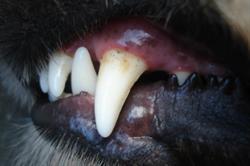A Common Problem in Dogs: Fractured Teeth

Ways Fractures Occur
Breaks and fractures can happen, for example, when the animal:
- Catches teeth on the metal wire found on kennels, cages, and fences
- Chews on hard objects, such as rocks, cow hooves, and bones
- Gnaws on hard objects over a long period of time which abrades the tooth structures and makes teeth fragile and easily broken
- Frequently chews on abrasive materials, such as the covering of a tennis ball, which wears teeth down over time to make them prone to breakage
- Fights with another animal
- Sustains injuries through trauma, for example, if hit by a vehicle
Types of Fractures
Classifying a tooth fracture is determined by the depth of the fracture. The following two types of crown fractures occur most commonly in dogs:
- Superficial or uncomplicated crown fractures, noted in charts as UCF
- Complicated crown fractures, noted in charts as CCF.
Uncomplicated crown fractures:
- Involve only the outer two layers of the tooth crown which consists of the enamel and dentin layers of the tooth
- Expose the dentin tubules and increase the chances for:
- Pain
- Ability for bacteria to migrate into the pulp chamber
- Endodontic infection
Complicated crown fractures:
- Expose the pulp or nerve chamber
- Are indicated with symptoms of:
- Pain
- Bleeding
- Increased chances for bacteria to result in pulp necrosis
- Higher infection rate
Examination
It is important to determine between the two types of tooth fractures in order to develop a treatment plan that is appropriate for the animal. When determining the amount of damage to the tooth it is generally recommended to examine the animal under anesthesia. The benefits to having the animal anesthetized include:
- Removes the potential for continued or increased pain felt by the animal
- Reduces the opportunity for injuries caused to the veterinarian by the animal if frightened or in pain
- Eases the manipulation of the animal for examination of the damaged tooth
- Reduces the exposure and increases the accuracy when obtaining dental x-rays
X-rays
Without a dental radiograph, it may be difficult to determine the appropriate method for treatment. Dental x-rays provide information that can be used to:
- Assess the vitality of the tooth
- Determine the integrity of the root of the tooth
- Identify if there is any bone destruction or damage around the root tip
- Uncover any rising pockets of infection
Treatments
Treating uncomplicated crown fractures with damage only to the enamel and/or dentin may include methods such as:
- Smoothing sharp fracture edges
- Applying resin bonding agents or adhesives onto dentin to seal pores and reduce sensitivity
Treatments options for a complicated crown fracture requires more extensive procedures. Three types of methods include:
- Vital Pulp Therapy
- Used to treat fractures when the injury to the pulp has occurred within the last 48 hours
- When the injury has gone beyond 48 hours, this therapy is usually not chosen because the increased chances of increased bacterial contamination gives decreased chances of treatment success
- Method requires:
- Removal of the contaminated pulp
- Placement of a filling to preserve the tooth
- Root canal therapy
- Used to treat fractures of undefined age, or when there is no other appropriate option to save the tooth
- Method requires:
- Removal of entire tooth pulp through the use of specially designed files
- Replacement of pulp with a specially created material, gutta percha
- Protecting the dental work by placing either a metal prosthetic or either a porcelain or ceramic crown over the remaining tooth crown
- Extraction of the damaged tooth
- Use provides an effective method for removal of infection and pain, but is less desirable as animal loses the function of the tooth
- Method requires:
- Removal of the entire tooth
- Degree of difficulty depends upon the tooth type and may involve the need for additional procedures that involve tooth sectioning and bone removal.
An uncovered fracture or broken tooth will require immediate attention in order to fight against the chance for infection. For more tips on diagnosing and correcting fractured teeth in dogs, contact your Covetrus representative today at 855.724.3461.
Sources:
http://www.wellpets.com/vet-dentistry-fractured-teeth/
http://www.dogandcatdentist.com/services.html
Need Regulatory Assistance
If you need help with regulatory or licensing issues, we're happy to help. We have a wide variety of resources to help you when issues arise.

Careers
Are you looking for a place to let your talents shine? At Covetrus, we help our practitioner customers better serve their patients and take pride in providing the best customer experience possible. Search our open positions to see our available opportunities.
Newsletter
Stay current with what’s going on with Covetrus, subscribe to receive our newsletter and email communications. Subscribers will receive the latest information in practice management, sales and marketing, animal health, and more.


Leave a comment